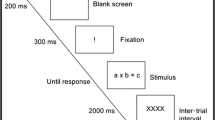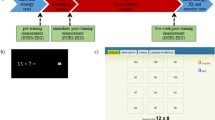Abstract
This study uses event-related brain potentials to examine the extent to which training in arithmetic calculation increases problem-solution associative strength and reduces the problem-size effect. Participants were presented with a classic equality verification task in two sessions. The problem size was manipulated by using small, medium and large problems. Since the problem-size effect has been related to a modulation of a late positive slow wave and explained in terms of differential frequency of use with problems, practice was expected to modify the amplitude of this positive component. Results showed that the amplitude of the positive slow wave increased with problem size and decreased with practice, suggesting that practice is an important determinant of the problem-size effect.


Similar content being viewed by others
References
Ashcraft M (1992) Cognitive arithmetic: a review of data and theory. Cognition 44:75–106
Groen GJ, Parkman JM (1972) A chronometric analysis of simple addition. Psychol Rev 79:329–343
Kirk RE (1996) Practical significance: a concept whose time has come. Educ Psychol Meas 56:746–759
LeFevre JA, Sadesky GS, Bisanz J (1996) Selection of procedures in mental addition: reassessing the problem size effect in adults. J Exp Psychol Learn Mem Cogn 1:216–230
Núñez-Peña MI, Honrubia-Serrano ML, Escera C (2005) Problem size effect in additions and subtractions: an event-related potential study. Neurosci Let 373:21–25
Núñez-Peña MI, Cortiñas M, Escera C (2006) Problem size effect and processing strategies in mental arithmetic. NeuroReport 17:357–360
Pauli P, Lutzenberger W, Rau H, Birbaumer N, Rickard TC, Yarmoush RA et al (1994) Brain potentials during mental arithmetic: effects of extensive practice and problem difficulty. Cogn Brain Res 2:21–29
Pauli P, Lutzenberger W, Birbaumer N, Rickard T, Bourne L (1996) Neurophysiological correlates of mental arithmetic. Psychophysiology 33:522–529
Zbrodoff NJ (1995) Why is 9 + 7 harder than 2 + 3? Strength and interference as explanations of the problem-size effect. Mem Cogn 23:689–700
Zbrodoff NJ (1999) Effects of counting in alphabet arithmetic: opportunistic stopping and priming of intermediate steps. J Exp Psycho Learn Mem Cogn 25:299–317
Zbrodoff NJ, Logan GD (2005) What everyone finds: The problem-size effect. In: Campbell JID (ed) Handbook of mathematical cognition. Psychology Press, New York, pp 331–346
Acknowledgments
This research was supported by grants Consolider-Ingenio 2010-CSD2007-00012 and SEJ2006-000496/PSIC from the Spanish Ministry of Science and Technology and SGR2005-00953 from the Generalitat de Catalunya.
Author information
Authors and Affiliations
Corresponding author
Rights and permissions
About this article
Cite this article
Núñez-Peña, M.I. Effects of training on the arithmetic problem-size effect: an event-related potential study. Exp Brain Res 190, 105–110 (2008). https://doi.org/10.1007/s00221-008-1501-y
Received:
Accepted:
Published:
Issue Date:
DOI: https://doi.org/10.1007/s00221-008-1501-y




